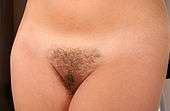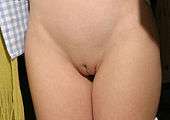Bikini waxing
Bikini waxing is the removal of pubic hair using a special wax, which can be hot or cold, that adheres to hairs and pulls them out when the wax is removed quickly from the skin, usually with a cloth strip. While the practice is mainly associated with women, male waxing is sometimes done to remove men's pubic hair.[1]

A bikini line is the area of the upper leg and inner thigh in which pubic hair grows that is normally not covered by the bottom part of a swimsuit.[2] In some cultures, visible pubic hair in this region is disliked and/or considered embarrassing and so it is sometimes removed.[2] However, some people remove pubic hair that will not be exposed for aesthetics, personal grooming, hygiene, culture, religion or fashion.
Technique
Pubic hair can be removed in a number of ways, such as waxing, shaving, sugaring, electrolysis, laser hair removal or with chemical depilatory creams. Waxing involves applying melted, usually hot, wax to the pubic hair that an individual would like to remove. The wax, which adheres to the hair as it hardens, is then covered with small strips of cloth. When the wax hardens sufficiently, the cloth is pulled off quickly, removing the hair from its roots as the wax is pulled away. Waxing can be performed on oneself privately using a home kit or by a cosmetologist at a salon or spa.[3]

If a person has never been waxed before, or has not been waxed for a long time, it may be necessary to trim the pubic hair using scissors or an electric razor prior to waxing.[4][5] A patch test is recommended, usually on the upper thigh, to test for allergies or skin sensitivities to the ingredients in the wax. Sometimes a hair growth inhibitor is applied after waxing, which slows the regrowth of hair if applied daily for an extended period of time.[3]
It is common to apply an antiseptic cleaner and powder to the area prior to waxing. Wax is applied with a spatula in the direction of hair growth the size of a strip about 2 inches (5.1 cm) wide and 4 inches (10 cm) long. When the wax is set but still pliable, the wax strips are pulled away against the direction of hair growth while keeping the skin taut. The strip is ideally pulled off as swiftly as possible.[4]
The pubic area is one of the most sensitive areas in the body and during the procedure special attention must be paid to avoid irritation. Pain directly resulting from the procedure can be slight or severe and can continue from several seconds to several minutes. Some people experience less pain during subsequent treatments. It can be helpful to take a mild anti-inflammatory medication (such as ibuprofen) an hour or so before waxing to reduce potential pain from the waxing.[6] Products such as topical anesthetics are available to lessen the pain involved.[3] A bikini wax during pregnancy is generally more painful, due to increased sensitivity.[7] The type of wax used for bikini lines is often made from a mixture of beeswax and tall oil rather than the more common synthetic waxes used for waxing regular leg hair. Beeswax is considered stronger and more effective at removing the thicker and coarser pubic hair.[8]
Sometimes bumps or in-grown hair can result from waxing. Isolated hairs can be removed with tweezers or electrolysis.[5] Discomfort following the procedure generally lasts two to five days or less.[9] Application of egg oil for a few days post-waxing can help moisturize the skin and reduce inflammation, pain or growth of bacteria.[10] With repeated removal over time, pubic hair becomes weaker and grows more slowly, leading to easier removal with less pain and less frequent waxing.[11]
Styles



Some people modify their pubic hair either to fit in with societal trends or simply as an expression of their own style or lifestyle, while others object to any styling or do not practice it because of cost considerations.[12][13]
"Natural" (also known as "au natural" or "bush") refers to pubic hair that has not been removed, trimmed or styled at all.[14] "Trimmed" or "cut" refers to pubic hair that has been shortened, but not completely removed other than shaving the inner thighs. Some women trim, but keep hair on their labia, while removing the pubic hair on the mons pubis. Pubic hair may be styled into several basic styles[4](p139)[15][16] which are often referred to by different names.[17] Salons often use their own unique names for common types of waxing, for example referring to a Brazilian with a "landing strip" as a "Mohican" or a "Hollywood" as "Full Monty".[18][19]
The three major types are described below:
American waxing
American waxing is the removal of only the pubic hair that is exposed by a swimsuit, depending on the style of the swimsuit. For a bikini, it would be hair at the top of the thighs and under the navel. It is also known as a "basic bikini wax",[4][15][16] "triangle", or "bikini line", as it involves waxing hair from the sides to form a triangle so that pubic hair cannot be seen while wearing a swimsuit.[20] Bikini bottoms or underwear are usually worn while getting an American wax. A normal American waxing job takes about 20 to 30 minutes to complete.[4]
French waxing
French waxing (sometimes called a landing strip or a partial Brazilian wax) leaves a vertical strip of pubic hair about 1.5 inches (3.8 cm) wide and 3 inches (7.6 cm) long just above the vulva.[4][15][17] Hair around the anus area and labia may be removed. The landing strip wax has become popular with models who must wear garments of an extreme narrowness in the crotch region. To create the "landing strip" (a line of hair) practitioners and clients prefer either lying face up or lying face down. Sometimes hard wax is used, though strip wax works as effectively.[4]
Brazilian waxing
Brazilian waxing (or the sphinx wax[21]) is the removal of all pubic hair from the pelvic region, vulva, labia, perineum,[22][23] and anus, while sometimes leaving a thin strip of hair on the mons pubis.[4][15][16][17][24] It can be used by those who wear thong bikinis.[25] Brazilian waxing is also known as a full Brazilian wax, full bikini wax, or the Hollywood wax.[4][16][17] This style was first called the Brazilian wax by the J. Sisters salon in Manhattan, founded in 1987 by seven sisters named Padilha from Brazil.[26][27]
Brazilian waxing is more controversial than other types of waxing.[28][29] Like all waxing, it can be a physically painful experience during and after waxing.[22][29][23][30] Some believe it is more unpleasant to receive cunnilingus from a bearded partner after getting a Brazilian wax.[29][30] Some critics of the procedure believe that Brazilian waxing can contribute to making an adult woman look underage, claiming that this may be one reason for its popularity in the sex industry.[24][28][30] There is also a health risk involved if it is not done properly, as well as a risk of infection if done on a person with a weakened immune system.[31]
Health
In a 2016 the Journal of the American Medical Association published a study in which it was found that out of 3,316 American women surveyed, 84% reported a history of lifetime pubic hair grooming, with 59% reporting that the primary motivations for grooming were for hygienic purposes.[32][33]
Bikini waxing has been credited with a significant global reduction in cases of pubic lice.[34] However, the medical community has also seen a recent increase in folliculitis, or infection around the hair follicle, in women who wax or shave their bikini areas.[35]
Social attitudes
In Islam, the removal of unwanted body hair is known as an act of fitrah. According to ethnologist F. Fawcett, writing in 1901, he had observed the removal of body hair, including pubic hair about the vulva, as a custom of women from the Hindu Nair caste.[36] In Western societies, removal of female body hair (except for head hair, eyelashes and eyebrows) has traditionally been considered appropriate when it was visible.[2]
In relation to pubic hair, with the reduction in the size of swimsuits, especially since the coming into fashion and popularity of the bikini since 1946, and the elimination of the skirt on swimsuits, the styling of pubic hair has also come into vogue.[2] The practice to remove more pubic hair continued with the popularity or fashion of even briefer swimwear, such as the thong, which exposed the buttocks.
Changes in lingerie styles also encouraged the removal of pubic hair,[4](p139) and the nude crotch—i.e., the total removal of pubic hair, such as in a full Brazilian or the Sphinx style—became considered by many to be erotic and glamorous. A nude crotch is considered by some to be more youthful looking.[2]:59 According to Tschachler, Devine and Draxlbauer, removal of all visible body hair has come to be seen as an important aspect of femininity.[2]:60
References
- Barker, Olivia (August 23, 2005), "The male resistance to waxing is melting away", USA Today, retrieved August 26, 2016
- Tschachler, Heinz; Devine, Maureen; Draxlbauer, Michael (2003), The EmBodyment of American Culture, Berlin-Hamburg-Münster: LIT Verlag, pp. 61–62, ISBN 978-3-8258-6762-1
- Staff writers (2005), "Get a Perfect Bikini Line", Cosmopolitan, vol. 238 no. 5, pp. 248–251, published online March 10, 2009, retrieved August 26, 2016
- Helen Bickmore; Milady's Hair Removal Techniques: A Comprehensive Manual; Thomson Delmar Learning; 2003; ISBN 1-4018-1555-3
- Lia Schorr, Shari Miller Sims & Shari Sims, SalonOvations' Advanced Skin Care Handbook, pages 94–95, 117-118, Cengage Learning, 1994, ISBN 1-56253-045-3
- Michael J. Klag, Johns Hopkins Family Health Book, page 769, HarperCollins, 1999, ISBN 0-06-270149-5
- Linda Murray, Leah Hennen & Jim Scott, The Babycenter Essential Guide to Pregnancy and Birth, page 576, Rodale, 2005, ISBN 1-59486-211-7
- Susan Cressy & Margaret Rennie, Beauty Therapy Fact File, page 293, Heinemann, 2004, ISBN 0-435-45142-1
- Hilda Hutcherson, Pleasure, page 190, Perigee, 2006, ISBN 0-399-53286-2
- Mahmoudi M; Others (2013). "Anti-inflammatory and analgesic effects of egg yolk: a comparison between organic and machine made". European Review for Medical and Pharmacological Sciences. 17 (4): 472–6. PMID 23467945.
- Gekas, Alexandra (October 18, 2013). "Waxing 101: Tips and Tricks for Beginners". Woman's Day. Retrieved August 27, 2016.
- Turner, Beverley (November 15, 2013). "Pubic hair is back". Telegraph.co.uk. The Daily Telegraph.
- Shire, Emily (October 4, 2014). "Waxing: Damned if You Do and Damned if You Don't: How Pubic Hair Became Political". The Daily Beast.
- Germinsky, Lisa (December 11, 2008). "Bush is back". Salon.com. Retrieved May 9, 2013.
- "Different Types of Bikini Wax and Application Techniques". Essortment. Archived from the original on February 18, 2011. Retrieved May 9, 2013.
- "Brazilian bikini wax". Brazilian Bikinis. Archived from the original on November 17, 2012. Retrieved May 9, 2013.
- Salinger, Eve (2005). The Complete Idiot's Guide to Pleasing Your Woman. New York: Alpha Books/Penguin Group. p. 196. ISBN 978-1-59257-464-3.
- Hiscock, Jane; Frances Lovett (2004). Beauty Therapy (2nd ed.). Oxford, UK: Heinemann Educational Publishers. p. 325. ISBN 978-0-435-45102-8. Retrieved May 9, 2013.
- Latour, Stephanie (2002). Erotic Review's Bedside Companion: An ABC of Delightful Depravity. Anova Books. p. 25. ISBN 978-1-84411-002-5. Retrieved May 9, 2013.
Salons offer a choice of waxing styles for women, including the widely renowned Brazilian or Mohican for those concerned not to reveal a single stray pube in the inciest, winciest beachwear, while The Hollywood denotes the full monty.
- Grey, Maggie (June 30, 2012). "Basic Pubic Hairstyles". The Landing Strip. Retrieved June 13, 2014.
- Weigle, Elizabeth Anne. The American trend of female pubic hair removal. Diss. uga, 2009.
- Valhouli, Christina (September 3, 1999). "Faster Pussycat, Wax! Wax!". Salon.com. Archived from the original on March 12, 2012. Retrieved December 30, 2017.
- Blue, Violet (2002). The Ultimate Guide to Cunnilingus. San Francisco: Cleis Press. pp. 66–67. ISBN 978-1-57344-144-5.
- Boston Women's Health Book Collective, The (2005). Our Bodies, Ourselves: A New Edition for a New Era (35th anniversary ed.). New York: Touchstone/Simon & Schuster. p. 4. ISBN 978-0-7432-5611-7.
- Jeffries, Fran (March 19, 2009). "A ban on 'Brazilian' bikini waxing?". The Atlanta Journal-Constitution. Better Health (blog). Archived from the original on October 23, 2012. Retrieved May 9, 2013.
- Ashley Fetters (December 13, 2011). "The New Full-Frontal: Has Pubic Hair in America Gone Extinct?". Retrieved December 15, 2011.
- Venema, Vibeke (December 31, 2016). "The women who invented the Brazilian wax". BBC News. Retrieved December 31, 2016.
- Kirsch, Melissa (2006). The Girl's Guide to Absolutely Everything. New York: Workman Publishing. p. 424. ISBN 978-0-7611-3579-1.
- Joannides, Paul (2006). Guide to Getting It On. Waldport, Oregon, USA: Goofy Foot Press. pp. 233–246, 528–531. ISBN 978-1-885535-69-6.
- Godson, Suzi (2005). Sexploration: An Edgy Encyclopedia of Everything Sexual. Berkeley, California USA: Amorata Press. pp. 89, 161. ISBN 978-1-56975-505-1.
- Tweed, Katherine (July 11, 2007). "Woman Almost Dies After Bikini Wax". Fox News. Archived from the original on July 13, 2007. Retrieved July 31, 2007.
- Rowen TS; Gaither TW; Awad MA; Osterberg E; Shindel AW; Breyer BN (October 2016). "Pubic Hair Grooming Prevalence and Motivation Among Women in the United States" (PDF). JAMA Dermatology. 152 (10): 1106–1113. doi:10.1001/jamadermatol.2016.2154. ISSN 2168-6068. PMID 27367465.
- Hoffman, Jan (June 29, 2016). "Most Women Prefer to Go Bare, Citing Hygiene (and Baffling Doctors)". New York Times. Retrieved June 30, 2016.
- Jason Gale; Shannon Pettypiece (January 13, 2013). "Brazilian Bikini Waxes Make Crab Lice Endangered Species". Bloomberg. Retrieved October 26, 2013.
- Hackley, Barbara; Kriebs, Jan M.; Rousseau, Mary Ellen (2008). Primary Care of Women: A Guide for Midwives and Women's Health Providers. Jones & Bartlett Publishers. p. 833. ISBN 9781449666156.
- F. Fawcett (2004) [1901]. Nâyars of Malabar. Asian Educational Services. p. 195. ISBN 978-81-206-0171-0. Retrieved June 23, 2011.